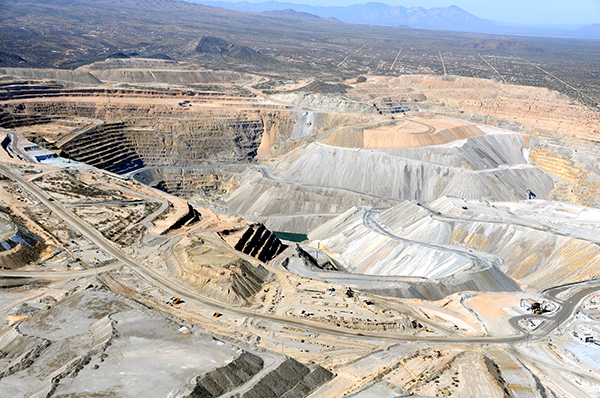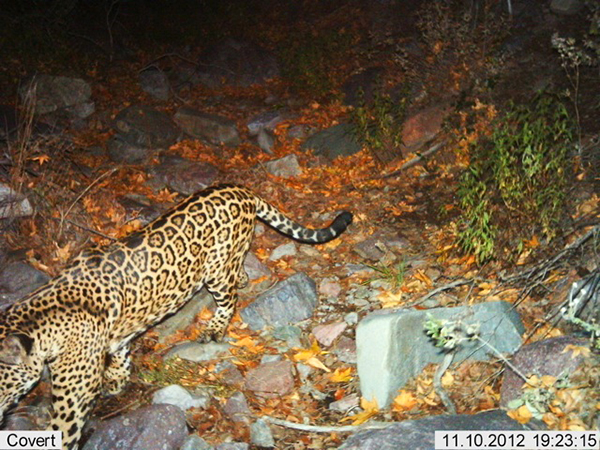In America, mining on public lands is governed by The General Mining Law of 1872. Originally passed as an incentive to attract people from the East to settle in the West, it allows anyone (including foreign companies) to stake a claim on public domain land for hard-rock minerals—such as gold, copper, silver, and uranium—and to extract the ore without paying any royalties to the federal government. This law contains no provisions for environmental protection. In 1872 Arizona had 4,600 people. In 1950 Arizona had 750,000 people. In 2023 Arizona has over 7 million people. In 1872, miners used pick-axes and hand shovels. Today, the equipment used can topple mountains.
The U.S. Environmental Protection Agency estimates that hard-rock mining has polluted 40% of the headwaters of Western watersheds with mine runoff. Strip mines and open pit mines have destroyed thousands of acres of habitat. According to EARTHWORKS estimates1 it will cost taxpayers between $32 and $72 billion to clean up these mines. Taxpayers are also potentially liable for billions more in clean-up costs of currently operating mines. And this does not factor in the value of the full extent of the environmental damage or the current potential threat of U.S. laws being enacted to open up public lands for many more mines.
While it is true that the 1872 Mining Law has been unchanged for over 150 years, a law passed in 1976 has created some environmental checks and balances. This is the 1976 Federal Land Policy Management Act, which decrees that mining companies must convince the U.S. Forest Service (and other agencies) that their proposed mine is in compliance with the law. The U. S. Forest Service has to write an Environmental Impact Statement (EIS) and are often required to either reject or approve the mining proposal by undergoing the National Environmental Protection Act (NEPA Process). In addition to being approved in the NEPA process, the mining proposal has to be in compliance with:
- the National Preservation Act (having to do with Native sacred sites and any other cultural concerns)
- the Endangered Species Act
- the Clean Air Act
- the Clean Water Act
While the 1976 Federal Land Policy Management Act does slow down the process for mining companies, 99.9% of the applications for mines on public lands are approved. One open pit mine was rejected in the region of Yellowstone National Park when President Clinton was vacationing there and someone managed to regale him with an accurate picture of how the proposed mine would damage the whole region. Clinton made a few phone calls and that mine did not happen. But in general, these permits go through, unless the time it takes to obtain the required permits causes the mining companies to pay out too much money to make it worthwhile, or it takes so long they lose their investors.
Proposed Mines in Arizona Lack Common Sense and Integrity

In the case of the highly controversial proposed Rosemont Copper Mine in the Santa Rita Mountains of Southern Arizona, those of us opposed to the mine have high hopes because, although the company behind the proposed mine—Hudbay Minerals—has managed to obtain most of the needed permits (including approval from the U.S. Forest Service in the NEPA process on July 1, 2013 and the Clean Water Act 404 permit in 2019), they have yet to be approved as being in compliance with the National Preservation Act and the Endangered Species Act. Hudbay is also hampered by multiple lawsuits coordinated by Save the Scenic Santa Ritas, joined by Sierra Club, Arizona Mining Reform Coalition, and Center for Biological Diversity. Separate suits were also filed by the Tohono O’odham Nation, Pascua Yaqui Tribe and the Hopi Tribe (impacts on cultural resources); and Center for Biological Diversity (impacts on endangered species). Meanwhile, Hudbay is currently carving roads, drill pads and clearing ground for tailings piles on property it owns on the western slope of the Santa Ritas. The activity is filling ephemeral stream beds and disturbing habitat in anticipation of final approvals to move forward with the first phase of the Copper World Complex, a 44-year mining plan the company hopes to launch sometime within the next two years.
“When Hudbay came in, it was focusing only on Rosemont at first, because the east side is the more desirable place to mine,” Steve Brown, interim president of SSSR, told the Arizona Mirror. “When they discovered that they couldn’t dump their tailings on Forest Service land, they said, ‘Well, we’re going to just go over to the other side.’”

The Santa Rita Mountains are a visual part of my home bioregion, northeast of Rio Rico Arizona, where I live on the university campus at Avalon Gardens & EcoVillage. To the southeast we have the beautiful Patagonia Mountains, where five mining proposals are obtaining permits to mine on public lands. Three of these proposals are for large-scale mining operations, and two are smaller “placer” mines. The larger three mining proposals are backed by Canadian companies, as is the Rosemont Mine/Copper World Complex by Hudbay Minerals. The reason for this is that the Canadian stock exchange allows for more speculation than the American stock exchange. A company in Canada can receive a great deal of money from investors while the project is in the planning stages, whereas in the U.S. there are limits to how much money they can rake in before they do what they say they are going to do.2
We also have the highly controversial Resolution Copper Mine (which is owned by Rio Tinto Group and BHP, two Anglo-Australian multinational companies that are the world's first and second-largest metals and mining corporations). The site of the Resolution Copper Mine is Oak Flat, one of the Apache people's holiest sites as well as one of Arizona's rare riparian zones. It was withdrawn from mining during the Eisenhower administration, and the Native and non-Native peoples who treasure the area thought it safe from future hard-rock mining.
But in December 2014, Arizona Sen. John McCain added a section to a defense spending bill that left Apache and other Native peoples reeling. That bill, the Southeast Arizona Land Exchange and Conservation Act, authorized the transfer of 2,400 acres of Tonto National Forest land to Resolution Copper, in exchange for more than 5,400 acres of private land.
The amendment gave Resolution Copper and its supporters access to one of the country's remaining large copper deposits.
Fighting the Good Fight
In order to get involved in protecting the Santa Rita Mountains from the Rosemont Copper Mine, please contact Save the Scenic Santa Rita’s at: http://www.scenicsantaritas.org/.
For latest news and how to join in the efforts to protect Oak Flat, contact http://apache-stronghold.com/
When Arizona Rep. Raul Grijalva and his team introduced the Clean Energy Minerals Reform Act (on the 150th Anniversary of the signing of the General Mining Act of 1972) they made the following statements:
Chair Grijalva: “The transition to a clean energy future will inevitably involve mining, there’s no question, but that doesn’t mean we should risk permanent damage to our sacred places, our wilderness, and our health. I don’t believe we can build a 21st century clean energy economy using a 19th century law. … That’s why I think it’s important as ever to put the [Clean Energy Minerals Reform Act] into law.”
Sen. Heinrich: “It’s time that we had a 21st century approach to mining in this country. Especially at a moment when we’re seeing increased efforts to create more domestic supply for many of these minerals, now is the right time to reform the oversight and statutory process under which we mine on our public lands.”
Rep. Lowenthal: “[The Clean Energy Minerals Reform Act] will help us fix the broken mining system on our public lands and it will also help us build a more sustainable, clean energy supply chain. … [Domestic mining] must be done in a way that meets the highest environmental standards, provides a fair return to American taxpayers, and—let me say clearly and loudly—respects tribal sovereignty.”
President Jeffrey Stiffarm, Fort Belknap Indian Community: “In the late 70s, a mining company out of Canada came in and got mining permits to do the first mine with cyanide leach mining. There were no rules or regulations in place to regulate what they did up there. They knocked down two mountains to extract gold, using cyanide leach. And then ten to twenty years later, they started running low on gold and ore up there, so they declared bankruptcy and they left. They left the federal government and the state of Montana with the responsibility to clean up the mess that they created. So now, the federal government and you the taxpayers are responsible for what that mining company has left and done to our sacred lands back home.”
ENDNOTES:
1 http://www.earthworksaction.org/1872.cfm
2 view the DVD Cyanide Beach to see how the executives of Augusta Resources (the original creator of the proposed Rosemont Mine Project) used a mine in Sardinia, Italy as a lure for investors http://www.investigativemedia.com/online-digital-release-of-cyanide-beach/).


